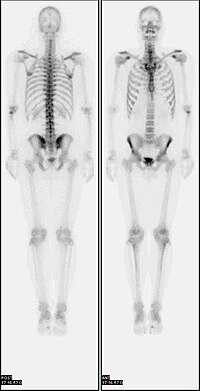
Photo from wikipedia
Objective We aimed to determine the factors contributing toward diffusely increased renal uptake on bone scintigraphy using technetium-99m (Tc-99m) diphosphono-propanedicarboxylic acid (DPD) in patients with end-stage renal disease. Patients and… Click to show full abstract
Objective We aimed to determine the factors contributing toward diffusely increased renal uptake on bone scintigraphy using technetium-99m (Tc-99m) diphosphono-propanedicarboxylic acid (DPD) in patients with end-stage renal disease. Patients and methods One-hundred and forty-three bone scintigraphies, performed between June 2007 and July 2013, in 135 patients with chronic kidney disease were analyzed retrospectively, including 22 bone scintigraphies (15 patients; eight women; seven men) with glomerular filtration rates less than 15 ml/min/1.73 m2. Patients with nephrocalcinosis were excluded. The clinical records of medication and underlying disease were reviewed retrospectively. The presence of renal artery calcification was visually estimated and the Hounsfield unit (HU) of renal parenchyma was measured by abdominal and pelvic nonenhanced computed tomography. Results Two patients underwent peritoneal dialysis and 13 underwent hemodynamic dialysis. Diffusely increased renal Tc-99m DPD uptake was observed on 15 of 22 (68%) bone scintigraphy images. Laboratory test results were not significantly different between the patients with or without increased renal uptake. A history of inflammatory conditions or antibiotic administration did not correlate with kidney visualization. The significant factor for diffuse renal tracer uptake on multivariate analysis was renal artery calcification (odds ratio: 18.42; 95% confidence interval: 2.01–79.43; P<0.001). The mean HU values were significantly higher in patients with diffuse renal tracer uptake (P=0.04) and renal artery calcification (P=0.02). Conclusion Small renal arteriolar calcification and a higher HU value of renal parenchyma could be associated with diffusely increased renal Tc-99m DPD uptake in patients with end-stage renal disease.
Journal Title: Nuclear Medicine Communications
Year Published: 2017
Link to full text (if available)
Share on Social Media: Sign Up to like & get
recommendations!